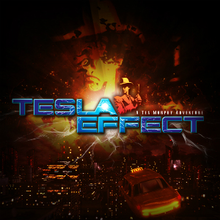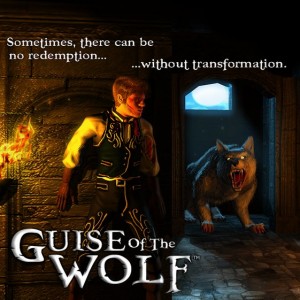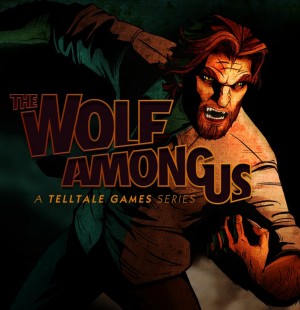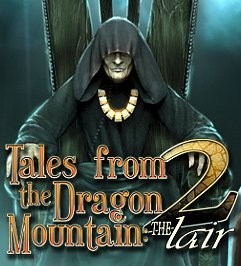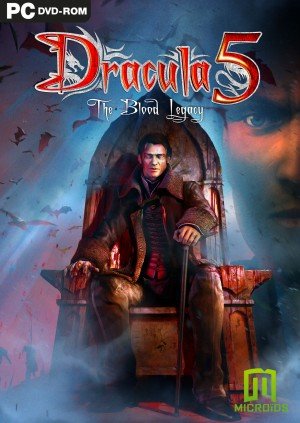Review for Tesla Effect: A Tex Murphy Adventure

Chris Jones and Aaron Conners proved themselves to be major players in the adventure genre during the ‘90s with Tex Murphy, their successful sci-fi detective noir series. Spanning several entries, from 1989’s Mean Streets to 1998’s Overseer, these popular games pushed the envelope of what adventure games could be, helping to usher in a host of technological and design features that were well ahead of their time. Now that time has caught up with the long-dormant franchise, the down-on-his-luck private investigator is back in a brand new case. Highly anticipated by the many fans who helped fund the game through Kickstarter (and even by those who didn’t), Tesla Effect is a sequel that continues the series’ high standard for tongue-in-cheek humorous storytelling, and satisfyingly pays off a setup over a decade-and-a-half in the making.
Spoiler warning for the ending of Overseer
When gamers last saw Tex, he and his girlfriend Chelsee Bando had just accepted a ride from a stranger when Tex’s speeder was stolen during a dinner date. Speeding through the smog-filled futuristic skyscape of 2043 New San Francisco, everything goes wrong when the driver turns to the pair, a gun in his hand. The gun pops off first one, then another shot, as Chelsee and (presumably) Tex are hit; the screen turns black. For years this cliffhanger ending left players desperate for resolution, and Tesla Effect provides it at long last. Picking up, as Tex believes, later that same night, Tesla Effect sees the P.I. awaken on his fire escape from what proved to be a tranquilizer dart, a bloody scrape on his forehead and nursing one hell of a hangover.
End spoiler
As Tex soon learns, it is actually the year 2050, and he has no recollection of what happened that fateful night or during the seven intervening years. Setting out to regain his memory and find Chelsee, Tex becomes ensnared in his biggest case yet, one which involves memory manipulation, reanimation of the dead, a cult bent on world destruction, and, at the core of it all, the scientific experiments of the 19th century inventor, Nikola Tesla.
The doctrine of “if it ain’t broke, don’t fix it” lies at the heart of every design decision Jones and Conners have made. Apart from the technological advances in graphics and sound (and the inevitable 16-year age bump evident in the actors’ faces), Tesla Effect could well have been made on the very heels of its predecessor. It stays faithful to its roots by implementing the same classic adventuring gameplay, 3D first-person roaming, and extensive FMV sequences that drive the story forward. Branching dialog trees are also still present, and, as with The Pandora Directive, decisions made during conversations influence what path Tex finds himself taking and which of several possible endings the player gets.
The better part of the game’s first half is spent on and around Chandler Avenue, familiar to any series veteran. Essentially the game hub, Tex’s office is located here, as are several shops where you’ll run into both old and new faces alike. Louie LaMintz, Rook Garner, Zack Williams, Archie Ellis, and Clint the chocoholic bum all make appearances, and serve to get Tex back on his feet in the early stages of the investigation, providing background information and filling in the gaps in his memory somewhat, while a much greater yarn begins to unravel.
Tex’s initial investigation into a shootout that occurred outside his building soon leads him to a literal dead end, corpse and all. As more bodies pile up, a tale of dual identities emerges, and soon Tex is not just dodging assassins but is fielding advances from a mysterious femme fatale. Each trail leads into unexpected directions, with Tex falling further and further down the rabbit hole. Has Tex truly stumbled upon a dark secret buried over a hundred years in the past? And is he able to let go of his one true love overnight? Tex must try to reconcile the pre- and post-amnesic parts of his life while retracing his own steps and being forced to decide what’s more important: the possibilities of a past he can’t recall or the certainties staring him in the face here and now.
Moving around (using the preset WASD keys to move and the mouse to tilt and turn the field of vision) is painless and intuitive, and an improvement over the sometimes clunky and cluttered interfaces of past games. Tex can examine objects in the environment, usually causing him to quip or crack wise with his trademark dry humor. Especially in the early stages of the game there are several flashback scenes, culled from the series’ previous releases – little video segments to remind players about a particular bygone plot point or character, or even just a humorous moment. After all, 16 years is a long time to remember every single detail. More fun than practical, these segments relate, for example, how Tex once got a hole shot in his hat, or explain his penchant for getting cracked in the skull with blunt objects. These touches nicely reinforce that Tesla Effect does not exist within a vacuum, though the story it tells fully stands on its own.
While time has left its mark on some of the returning cast (though surprisingly little on Jones himself as Tex), the 3D graphics show a marked improvement. I no longer had to concern myself with rotoscoped furniture, characters, even decorative household plants that eerily turned as I did, always facing me no matter what angle I was looking at them from. Smoother and more detailed than before, the graphics are far from photorealistic, however, marking the one aspect of production that doesn’t quite seem at peak performance. Still, objects can now be made out from afar, and no longer look like vague puddles of color in the distance. Explorable areas, especially Chandler Avenue, have grown in size and scope as well – there are more buildings to investigate than previously. Apart from Tex’s old stomping grounds, other environments include a luxurious glass-walled beach house, a creepy abandoned mansion in a swamp, and a quiet monastery atop a snowy mountain.
Cinematic sequences were once again shot on green screen with backgrounds digitally inserted. The actors themselves do not appear in the exploration segments of the game; if Tex enters an establishment or triggers a cinematic featuring an actual actor, the game switches to the full-motion video segments. The digital set extensions look great, and it’s often hard to tell where the real props end and the digital realm begins. The camera isn’t afraid of plenty of close-up shots, either, and while this gives the more believable actors the chance to really convey unspoken emotion through facial gestures (Steve Valentine’s Johanssen in particular is a joy to watch), it also exposes the grotesque make-up effects used to transform ordinary humans into post-fallout mutants. Plenty of care clearly went into seemingly inconsequential things, like including a spinning ceiling fan as part of the scenery, or faithfully adjusting the backgrounds to match the camera’s field of view.
The acting is a bit of a doubled-edged sword, ranging from heartfelt and intense to blatantly over-the-top. While most of the bigger roles have been capably filled, the supporting cast hams it up quite generously, though this is far from a complaint; having characters like Rook and Louie deliver out-of-the-ordinary realistic performances would have robbed them of their appeal and been at odds with their outlandish appearances. Unfortunately, Tex’s Smart Alex – essentially a talking PDA device that doubles as Tex’s inventory system – is sorely underutilized. Voiced by Mystery Science Theater 3000’s Kevin Murphy, Smart Alex is often completely absent for long stretches of time, only chiming in occasionally with a bit of (largely unfunny) banter with Tex, or commenting if I somehow caused Tex to die.
Speaking of which, while it is entirely possible to walk Tex into certain doom any number of ways, often at the hands of some unsavory creature or other, death doesn’t carry a very large penalty with it. You’ll simply be restored to the last save… and the game auto-saves A LOT! Far more punishing are the points deducted for dying. Remember earning points in adventure games? The kind awarded for making smart decisions, being thorough in your techniques and diligent in your observations? Well, points are back in Tesla Effect – at least so it would seem. I quickly found out, however, that there was no way to tell just how many points I had racked up, or how many were possible. As it turns out, there is an invisible tally being kept somewhere behind the scenes, and it determines which of nine possible detective ranks is bestowed upon you at the game’s completion. This less-than-transparent method of tracking your progress, along with the completely arbitrary rankings which carry no discernible rewards, makes the point system rather irrelevant.
There were also one or two moments throughout the adventure where I was left scratching my head, wondering if I’d missed or misunderstood some vital clue. At first I assumed these were due to my not paying close enough attention, when in fact they were the result of branching dialog trees. With multiple paths through each conversation, a person or place mentioned in one response could be entirely omitted in another, causing confusion when these facts were casually thrown around later. While a tad disorienting, I can accept that such discrepancies are bound to sneak into a game with such a complex web of narrative threads. Besides, it really only makes a minimal difference, as playing through the game multiple times to uncover each possible ending inevitably reveals new tidbits missed the first time through.
These branching conversation paths give players a choice of three possible responses. This is commendable, but I found it very difficult, if not impossible, to know which tactic I was actually choosing based on the prompts displayed. A vital decision may have a positive or negative response, and one that makes light of the situation and dismisses it as a joke. Though I wanted to stay true to how I thought Tex would answer, I couldn’t readily tell which was which based on the insufficiently descriptive clue. For example, the dialog option “Buddy Speak” in an early conversation with Louie is actually a way to question why he treated Tex like a stranger, which wasn’t made sufficiently clear. Again, this wasn’t a big concern for me, as I was content to let the chips fall where they may. However, players attempting to steer the game towards a certain outcome by having Tex behave in a particular way will likely be forced to resort to trial and error, replaying conversations over and over to get the desired result.
The musical soundtrack impressed me to a much higher degree, and was easily one of the game’s standout characteristics. So much so, in fact, that I found myself really missing it during the silent beats in dialog scenes. Alternating between a jazzy brass vibe and a plucky background bass tap, the fully orchestrated score kicks things up a few notches during the game’s finale, ending on an exciting, action-filled theme song during the credit roll. As a whole, the music fits the game’s noir detective atmosphere and nicely elevates the experience to the same cinematic level achieved by its predecessors.
In the gameplay department – especially gameplay, in fact – Tesla Effect stays true to its classic puzzle roots. Tex is able to pick up items in the environment (including unwieldy items like a ladder and an anvil) and carry them with him to progress past environmental obstacles elsewhere. The inventory screen, including the interface for combining items, is cleaner and less cluttered than in previous games, and is accessible via a mouse click or keystroke. I rarely felt challenged by the puzzles themselves, or at a loss as to how to progress past an area; most items have a clear use and there isn’t an overwhelming number to find in each area. The only time I wasn’t able to easily advance was when I had to collect multiples of a specific item and was unable to locate one. Rather than roadblocks, the puzzles for the most part serve as narrative aides and keep the game moving at a fairly fast clip. Later parts of the game take a different approach by incorporating movement-based challenges such as navigating a mine maze and solving standalone brainteasers in the form of sliding block puzzles and such. The endgame, however, sadly deviates from the established puzzle formula by presenting a challenge requiring dexterity and speed instead of clever out-of-the-box thinking.
Though experienced adventure gamers will likely not find the puzzles to be incredibly difficult, the game does offer the option to play with a bit of assistance. A “Casual” mode enables an in-game hint system, which walks players through the needed steps to progress, though each time you take advantage of this guide a number of points are subtracted from your overall total. Additionally, this mode makes it easier to find interactive objects; activating a flashlight from your inventory and passing its beam over an item in the environment that can be picked up makes it sparkle in the light. Both of these help features can be disabled by playing in “Gamer” mode.
In the end, Tesla Effect doesn’t reinvent the wheel, nor does it aim to. What it does attempt – and successfully accomplishes – is to mark the comeback of a beloved adventure gaming icon, and to do so in a way familiar to legions of fans. Finally tying up story ends left loose for years, Tesla Effect offers up a full-length Tex Murphy adventure, comfortably taking between 12-15 hours to complete (leaning towards the lengthier end of the spectrum if one takes the time to soak in and investigate fully, as many fans will surely be eager to do). Best of all, it manages to do all this while staying true to the established formula that came before. Whether it’s a final farewell to cap off the franchise or a sign of more adventures to come is anybody’s guess, but Tesla Effect unequivocally proves that old dogs don’t necessarily need to learn new tricks.
Review copy provided courtesy of GOG.com.
WHERE CAN I DOWNLOAD Tesla Effect: A Tex Murphy Adventure
Tesla Effect: A Tex Murphy Adventure is available at:
- GOG -75%
- HumbleBundle
- Amazon
Our Verdict:
Though he has lost his memory, Tex hasn’t lost any of his charm or humor, and Tesla Effect is a beautifully crafted love letter to a bygone era, made specifically with series fans in mind.


